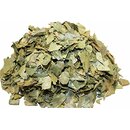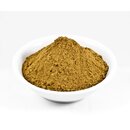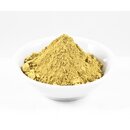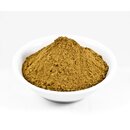Lapacho Iperoxo inner bark cut
Nature's gift to detoxify and balance the body
In the 1970s, Western scientists learned about the extraordinary effects of Lapacho inner bark from the Kallawaya, the "lords of the medicine bag," as they are respectfully called by the locals. Established medicine initially laughed them off at the time. In the meantime, however, there are more recent studies that confirm what the botanist Professor Accorsi already stated at that time:
Lapacho causes a significant increase in red blood cells.
The red blood cells are the oxygen logistics in the body, i.e. they are of crucial importance for almost all health processes, the regeneration and vitality of the body. A good supply of oxygen in the cells is the basis for physical health.
When studying the patients' reports, it was noticeable that improvement occurred after a short period of time, even in the case of the most severe ailments.
Dr. Meyer of the State University of Tucuman in Argentina isolated the active ingredients, including a quinone that supports liver metabolism. (The liver is our detoxification organ).
Not only that. This quinone helps with the respiratory chain and the energy supply of the cells! Thus, it becomes understandable what the beneficial effect is based on.
Nevertheless, these substances do not act in isolation, but only in concert with the other plant components of the Lapacho inner bark.
There are, for example, the saponins, the soap substances, which Lapacho contains in high measure. They act as antimyotics in the bark of the tree, protecting it from harmful fungi or even driving them away. What makes Lapacho saponins particularly effective in humans is that they facilitate the absorption in the small intestine of important active ingredients of other herbs, (e.g., graviola (sirsak, soursop), which may contain fewer saponins.
Of particular note, Lapacho inhibits glucose absorption in the intestine, which is good for blood sugar levels and relieves the pancreas. Metabolism changes, cravings for sugar disappear, appetite normalizes.
Combined with the improved oxygen supply and regeneration, Lapacho turns out to be an ideal helper in losing weight.
And who has read this now with consciousness, knows that with these effects also a weight reduction can fall more easily!Above all in combination with the other little helpers.
Lapacho can almost not be overdosed. Studies have shown that up to 2 g per kg of body weight per day no side effects appear. But take it easy: drink the tea as long as you like it, it tastes very good warm and cold.
For all these reasons, it is not surprising that Lapacho is also called "Divine Tree" in South America, it is a tasty tea with stimulating effect on the body and it strengthens the cell structure.
For 1000 years, Lapacho tea has been an indispensable part of South American folk medicine. In Europe, the tasty tea and powder from the inner bark of the Lapacho has gained importance for several years.
The ingredients of Lapacho tea:
Anthraquinones, ascorbic acid (vitamin C) beta-carotene, beta-sitosterol, calcium, chromium, chrysophanic acid, dehydrisolapachone, dehydro-alpha-lapachone,
dehydrotectol, iron, fats, potassium, cobalt, carbohydrates, lapachol, magnesium, manganese, naphtoquinones, sodium, niacin, phosphorus, proteins, riboflavin, selenium, silicon, naphthoquinones, antraquinones, trace elements, strontium, barium, iodine
thiamine, xiloidin, zinc, tin.
Lapachol and the xiloidin are the most important.
Preparation as tea:
Add 1 tablespoon of Lapacho tea to 1 liter of boiling water and boil for 5 to 10 minutes, strain after 30 minutes.
The finished tea can be stored in the refrigerator for several days, preferably in the Flaska. Do not boil or store in aluminum pots or pots containing tin. Sweeten with erythritol or even better probiotic with yacon syrup.
Drink 1 liter a day. A Lapacho cure should last 6 weeks, 500 grams is enough for this. During this time, drink 1 liter of tea sipped throughout the day. The finished tea can be stored in the refrigerator for several days, preferably in a Flaska. Do not boil or store in aluminum pots or pots containing tin.
There are no known side effects. However, seek medical advice. Lapacho tea is not recommended during pregnancy.
Preparation as a bath:
Boil 1 tablespoon of bark in 1 liter of water for 5 minutes and steep for 20 minutes. Bathe at a temperature of 36 - 38°C for 20 minutes. Lightly dry the body and rest for half an hour in the pre-warmed bed.
Important note
The Lapacho harvest does not pose a threat to the rainforest because, as with our cork oak, the bark keeps growing back. On the contrary, since the trees do not release their strongest active ingredients until they are 40 years old, there has been a great deal of interest in leaving them standing since the high potency of the inner bark became known in the 1980s. Also since then, more and more plantations have been established with trees slowly coming into maturity, making good use of the rainforest areas.
Also, the lapacho tree is not threatened with extinction, as some sources claim, because there are more than 80 species of them worldwide and they are as common as pine trees in our country.
The bark is peeled 1x a year when the old trees are poached, 2x a year in the plantations. The highest quality parts are the thin, light-colored ones, from the innermost part of the bark. Good Lapacho tea has a light brown color and tastes gently nutty-caramel if not left to steep too long. It tastes good with a few drops of (soy) milk.
Lapacho is naturally felled for its good wood, because it is hard and robust against insect attack, pliable and very beautiful. Often sawdust is offered cheaply on the Internet in stores or on Ebay, for example, as "Lapacho inner bark". These products contain far less of the important active ingredients (such as lapachol and xiloidin).
Other names: Iperoxo, Tabebuia impetiginosa, Bignonia heptaphylla, Gelsemium avellaneda, Tabebuia nicaraguensis, Tecoma adenophylla, Acapro, Alumbre, Hakia, Guayacan polvillo, Bastard lignum vitae, South American Oak, Ironwood (for its strength), Bethabara, Madera negra, Canaguate, Bow Stick/Tree, Pau d'Arco ("bow wood" because it is so strong and flexible that it is good for carving bows), Capitaray, Surinam Greeheart (because its wood shimmers between green, yellow and brown), Carobeira, Chicala, Coralibe, Taheebo, Tahuari, Cortez, Taji, Ebano verde, Flor Amarillo, Tamura, Verdecillo
Summary
Lapacho inner bark stimulates the formation of red blood cells and strengthens cell structure.
It is used with success in many South American clinics.
Lapacho inner bark contains unusually high levels of minerals and trace minerals. The reddish-brown bark, from which an aromatic and fragrant tea is made, contains high levels of calcium, iron and potassium, and rare trace elements such as strontium, barium, boron, iodine.
The tea mainly has a strengthening effect on the body's defenses and against candida.
Especially with vitamin C together, for example, Camu Camu, Lapacho accelerates the elimination of unwanted substances in the body and strengthens the resistance.
| Shipping weight: | 0,60 Kg |
| Product weight: | 0,60 Kg |









